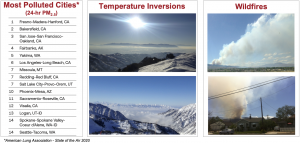Air Pollution, Atmospheric Physics, and Pollutant Exposure
Nearly 70 million people live in the western U.S. and growth continues as this region experiences rapid population increase. According to the 2010 U.S. Census regional population growth, from 2000-2010, in the western U.S. was 13.8%, the second largest growth region in the nation. While the population density in this region is low and correspondingly there should be fewer sources of anthropogenic air pollution, many areas in the western U.S. are currently designated as maintenance areas or are in nonattainment for at least one of the criteria air pollutants as defined by the National Ambient Air Quality Standards (NAAQS). This is exacerbated by unique air pollution sources (e.g., wind blown dust and wildfire smoke) and the local meteorological and orographical affects in the Intermountain Region. The mountainous terrain and elevation changes create synoptic weather patterns that lead to complex winds and atmospheric mixing that impact air pollution transport, dispersion, and accumulation. Air pollution in the western U.S. comes from wildfires, anthropogenic and biogenic emissions, secondary organic aerosol formation, and recirculating mountain air that mixes with urban air upwind. In addition, the severe drought in this region over the past eight years has caused an increase in the number of wildfires.

